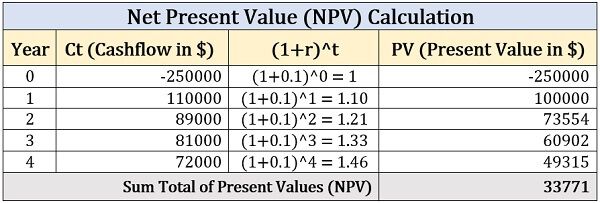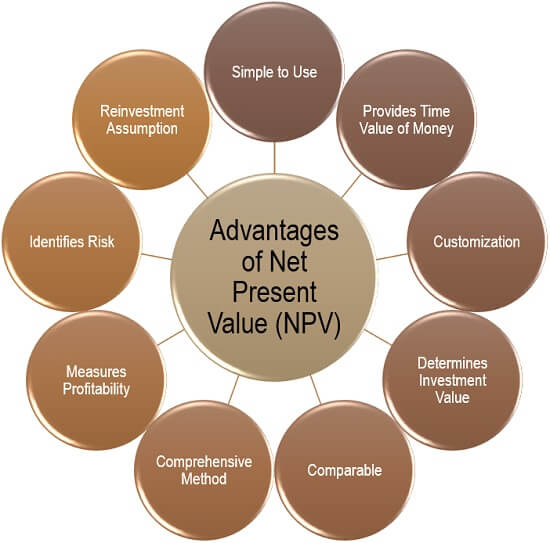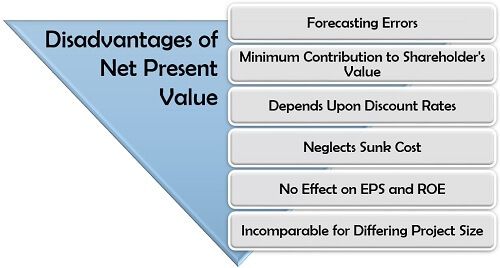Definition: The Net Present Value (NPV) is a means of evaluating the actual long-term profitability of an investment or a project through the initial outflow, future cash flows and time value of money. Also known as the discounted cash flow method, it backs the capital budgeting decisions of a company.
It is an effective means of forecasting the future outcome of a particular investment project. However, it cannot be taken as a single-handed tool for financial analysis since it is paired up with various other practices.
Content: Net Present Value (NPV)
Net Present Value (NPV) Formula
The NPV method provides the actual profitability of a project by assessing the future value of returns.
To compute the net present value of a project or any investment opportunity, we need to apply the following formula:
Where,
t is the Respective Year;
n shows the Total Number of Years;
Ct denotes the Cash Flow of the Respective Year;
r means the Discount Rate.
Net Present Value Example
An electronics manufacturing company plans to undertake a new investment opportunity, i.e., manufacturing of next-generation home theatre. The estimated life is four years.
Also, the discount rate is 10%. Whereas, the cashflows in the subsequent years are given in the following table:
| Year | Cashflow ($) |
|---|---|
| 0 | -250000 |
| 1 | 110000 |
| 2 | 89000 |
| 3 | 81000 |
| 4 | 72000 |
Net Present Value Calculation
Let us now breakdown the NPV formula for applying it to this problem, in the table given below:
The Net Present Value (NPV) is $33771.
Interpretation
Net present value is always shown in numerical value. Therefore The three possible outcomes of this computation are as follows:
Negative NPV: A negative NPV shows that the present value i.e., PV of the cash inflow is lower than its outflow. This type of investment opportunity is not worth it. It is denoted as:![]()
Zero NPV: It is when both the cash inflow and outflow have equivalent present values, i.e.:![]()
Positive NPV: Here, the PV of cash inflow is higher than that of its outflow. Therefore, it is a favourable investment idea. It is shown as:![]()
The value so acquired from the above computation is considered to be profitable if it provides a positive value. In the above example, the NPV is $33771; therefore, it is a suitable investment opportunity.
Advantages of Net Present Value
The net present value of a project in business guides the finance team for making wise decisions.
Let us now go through the numerous benefits it has for the company, in the long run:
Simple to Use: The net present value method is easy to apply to a real business project if the cash flows and discount rate are known.
Provides Time Value of Money: This method takes into consideration the effect of inflation on the future profitability of the project, thus estimating the time value of money.
Customization: In NPV, the discount rate can be adjusted according to the risk prevailing in the industry, along with various other factors, to obtain an appropriate output.
Determines Investment Value: The earnings throughout the project’s life span can be acquired by using the NPV method, which facilitates the company to know the future value of a specific investment.
Comparable: It facilitates the comparison of values generated in future, by two or more similar projects to find out the most feasible option.
Comprehensive Method: It finds the present value of a project by examining the effect of various factors like risk, cash outflows and inflows.
Measures Profitability: It is one of the most proficient methods of determining the actual profitability of a project in its lifetime.
Identifies Risk: In the absence of NPV, the managers would fail to estimate the risk of loss or meagre profitability in case of a long-lived project. It is otherwise possible by identifying the project with negative or zero NPV.
Reinvestment Assumption: The net present value is quite logical since, here the cash flows are not expected to be reinvested in the financial market, as done in internal rate of return.
Disadvantages of Net Present Value
Net present value is an effective means of evaluating a project’s profitability; however, it has certain drawbacks. These are as follows:
Forecasting Errors: While assessing the viability of a long-lived project, the estimation of cash flows may not be that accurate for the later years.
Minimum Contribution to Shareholder’s Value: The shareholder’s value maximization is the result of the overall growth of a company, whereas a high NPV contributes little towards it.
Depends Upon Discount Rates: Since this method is based on discount rates, even a slight change may result in entirely different NPV.
Neglects Sunk Cost: The sunk cost like research and development, trial, etc. incurred before the project starts, is mostly high. This cost is wholly ignored under the computation of NPV.
No Effect on EPS and ROE: Oftenly, the projects with high NPV but the short duration may not enhance the earning per share and return on equity.
Incomparable for Differing Project Size: The concept of capital rationing is applied in NPV; therefore, the projects which do not lie under the capital budget limit, cannot be compared under this method.
Conclusion
Imagine if you plan to invest in a million-dollar project that has a payback period of five years. Will you straightaway go by the profitability it generates in percentage?
No, since the value of money reduces with time and so does the profitability. Therefore, it becomes essential to analyze the net present value of future cash flows.
Leave a Reply